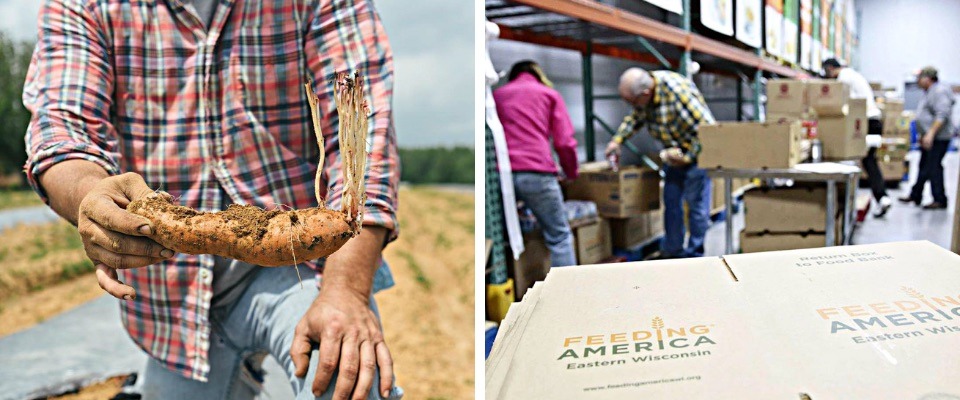How Feeding America Uses Technology to Turn Food Waste into Nourishment
Mark Bunting

One of the best parts of my job is learning about the companies we serve. That’s why I was moved to read recently about Feeding America, a hunger relief organization that rescues food that would be wasted, using the latest technological tools to reroute it to hungry Americans. Radius, VMware’s news and thought leadership site, recently published an in-depth look at the work Feeding America does, “Rescuing America’s Food.” It’s an incredible story and an in-depth look at how technology can improve our lives. The story immediately acknowledges the paradox of hunger in the U.S., one of the most prosperous nations on earth. Yet in part because of our plenty, Americans waste billions of pounds of food each year. While we’re all probably guilty of buying those vegetables with the best intentions only to toss them a week later when they’ve gone bad, the real culprit is food manufacturers, grocery stores and restaurants, which contribute to almost three-quarters of the waste. Even farms are guilty, wasting that other quarter of the total.

Much of that food is fresh, meaning time is of the essence to locate, transport, sort and redistribute it. From the story:
“When people eat better, their entire life gets better,” said Lisa Jericho, vice president of IT for Feeding America. “We want to show the people we serve the dignity to allow them food choice. We also know that more nutritious food is better for their family and their future.”
Often, the fresh foods Feeding America rescues are nearing expiration of an already short shelf life. Food must be transported, sorted and distributed in the fewest moves, to not waste money and beat food expiration dates.
Many factors impact this complex food distribution process, like the remaining shelf life and transportation costs and time. Feeding America also must consider the storage requirements of specific foods, available facilities and regional demand. Naturally, technology plays a key role in identifying the smartest moves.
“Our Produce Matchmaker application, for example, lets us match produce supply with the demand at the food bank based on their need,” explains Jericho. “Food banks log in online or through the mobile app to see what’s available and determine the best match for their community’s needs. They’re also able to arrange transportation, which in produce obviously is very time-sensitive. Members can be out working with local farmers or local grocery stores and yet still be able to source newly available produce in that moment, no matter where they’re at.
“MealConnect is one of our other mobile-enabled platforms, which matches demand at places like Starbucks or your local grocery store to ensure that food is picked up by both food banks and agencies and brought to the people they’re serving the next day,” she adds. Feeding America estimated the technology platform could aid in the rescue of another 740 million meals each year. Since the inception of the app, businesses and partners rescued more than 1 billion pounds of food with MealConnect.
Check out this video on the tech behind Feeding America’s rescues: https://youtu.be/EJy7PlS0Hz0 As you can see, Feeding America’s partner food banks depend on technology, yet most don’t have a lot of technical staff — nor should they, notes Steve Carlberg, Feeding America’s managing director of infrastructure and security: “They focus on getting food to their community.” He explains how his team offers technical support, so members can focus on their core mission:
That support previously included maintaining the hardware of about 360 servers for 50 locations. Now, he enlists the help of cloud provider managed services with Rackspace, a VMware Cloud Provider, to oversee physical infrastructure–shifting his team’s focus to their core mission–and to ensure ongoing availability of mission-critical technologies.
“Before transitioning to managed cloud services, we owned and maintained all the hardware. In some regards, that took away from our core mission,” he says.
And that touches on one of the other most satisfying parts of my job at Rackspace: doing the work that allows our customers to focus on their core mission, whatever that may be. It’s IT as a service, and it’s the future. Learn more about how Rackspace is here so you can be great.

Recent Posts
The Impact of AI on the BFSI Industry
January 27th, 2025
Convera Reimagines its Customer Service with AI: Highlights from the AWS re:Invent Presentation
January 20th, 2025
How to Manage and Optimize the Chaos of Cloud Operations
January 17th, 2025
Three Benefits of Embracing a FinOps Approach to Cloud Management
December 16th, 2024
How Are You Planning to Strengthen Cybersecurity in 2025?
December 11th, 2024